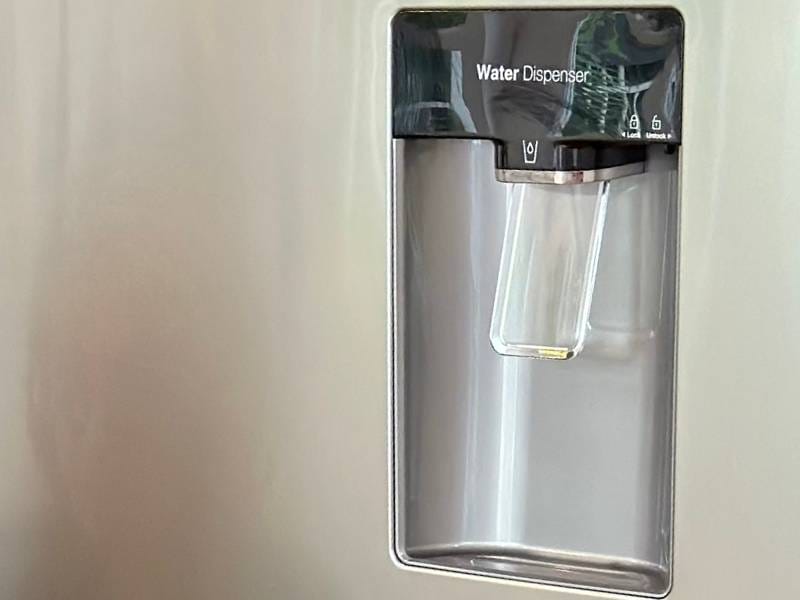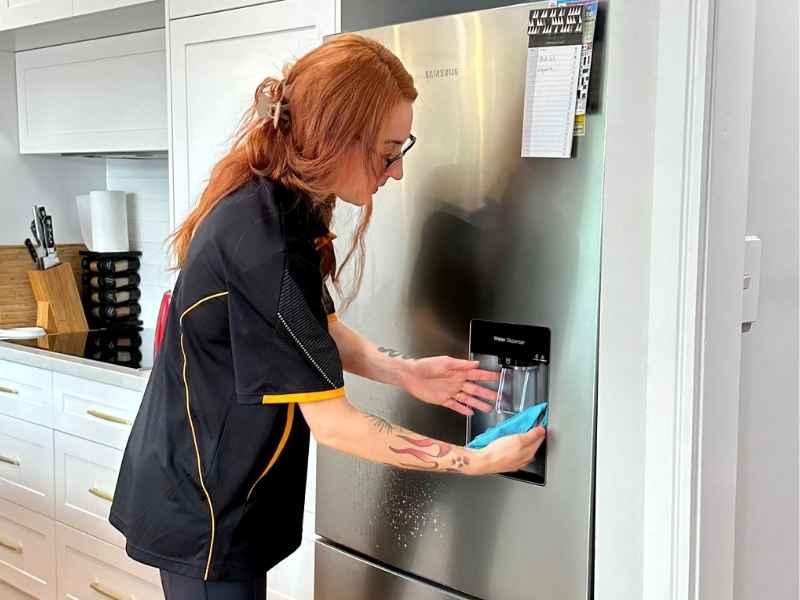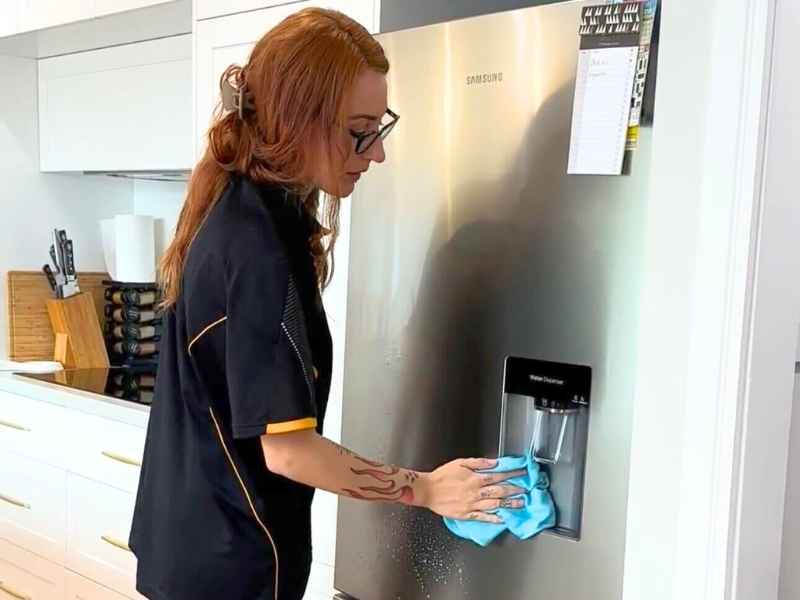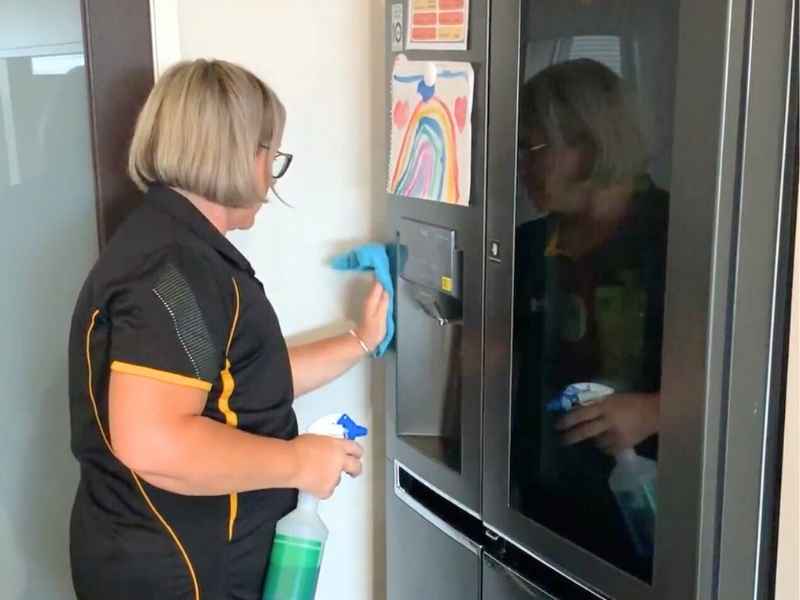On a hot summer day, there’s nothing more refreshing than a cold glass of water.
On the flip side, there’s nothing more unpleasant than noticing that the glass of water has a funky taste.
Stale- or metallic-tasting water and low flow are signs that your fridge’s water dispenser is dirty. To keep your water (or ice) clean and fresh, you’ll need to clean the dispenser regularly!
For most fridges, you can use white vinegar to flush the dispenser out and wipe the exterior surfaces. It also helps to remove limescale or even mould.
Take an hour (or less) out of your day to keep the water dispenser clean. Then you can enjoy a nice, cold drink anytime, worry-free.
How Often to Clean | Deep Cleaning the Water Dispenser | Cleaning Mould | Removing Limescale | Cleaning the Ice Machine
Do I Need to Clean the Water Dispenser on a Fridge?
Yes, you do! A clean water dispenser keeps your water and ice tasting fresh.
Minerals from your water supply can accumulate inside the dispenser, causing an unpleasant taste or odour. The buildup can also clog the dispenser and block water flow.
In the worst case, mould can grow in the drip tray or the reservoir.
Some signs you need to clean your fridge’s water dispenser ASAP include:
- Low water pressure
- Limescale crusts or deposits
- Metallic taste or smell in the water
Some fridges have an indicator that tells you the water filter needs replacing. When making the change, you can clean the nozzle and dispenser, too!
How Often to Clean a Refrigerator’s Water Dispenser
You should clean the fridge water dispenser every 3–6 months — or around the same schedule as deep cleaning the fridge.
If your fridge has an ice machine, you’ll need to wash that, too.
Spot clean the exterior parts, such as the dispenser nozzle, throughout the week alongside the outside of the fridge.
If you’ve booked a Maid2Match flat rate service, we’ll spot-clean the fridge exterior and water dispenser — but if you get the fridge cleaning add-on, we’ll clean inside, too!
Routine Water Dispenser Cleaning
Throughout the week, you’ll need to lightly clean your water dispenser!
Empty, rinse, and wipe the drip tray at the end of each day. This reduces any mineral buildup and minimises the risk of mould.
Wipe the water dispenser nozzle and any exterior surfaces to remove dust and moisture buildup. Use a soft cloth and some diluted white vinegar.
How to Deep Clean a Fridge Water Dispenser
Before anything else, check your owner’s manual for any specific instructions for cleaning the built-in water dispenser! You don’t want to accidentally void your warranty.
The manual will also tell you how to locate the shut-off valve and disconnect the water line. This will prevent water from coming out of the dispenser while you’re working.
Switch the water valve to the off position. As an extra precaution, you can turn off the water supply to the kitchen.
Flushing the water line and reservoir
Follow the manual to locate the water line or copper tubing that connects the water tank to the reservoir. Use a screwdriver to disconnect the tubing from the tank only.
To clean the inside of a water dispenser, start by placing a small funnel in the open end of the tube. Carefully pour 2–3 cups of distilled white vinegar into the tube.
Keep the funnel and tube raised so the vinegar flows through smoothly. Get someone to help you if needed!
Let the vinegar sit in the reservoir for 5–10 minutes. Then place a bowl under the nozzle before pushing the button to empty the reservoir and tube, until no more liquid comes out.
Dispose of the used vinegar in the kitchen sink.
Cleaning the dispenser nozzle
Dip an old toothbrush or soft-bristled brush into some distilled white vinegar and gently scrub the dispenser nozzle. Get into all the nooks and crannies so you can remove all the mineral buildup.
For a stainless steel fridge, avoid scrubbing if possible — you could end up with scuff marks! Instead, soak a paper towel in some vinegar and wrap it around the nozzle, then secure it with a rubber band.
Leave it overnight so the vinegar dissolves the mineral deposits. In the morning, remove the paper towel and wipe the nozzle clean.
Run the water for 30 seconds to remove any lingering vinegar taste.
Cleaning the dispenser area
Check if the drip tray is removable — if yes, lift or snap it out and wash it in warm, soapy water. Thoroughly dry the tray before putting it back into place.
If the tray isn’t removable, mix some warm water and dish soap in a small bowl. Dip a soft sponge into the cleaning solution, then scrub the tray clean.
Wipe the area around the dispenser with a clean cloth dipped in soapy water or some diluted white vinegar.
Rinse off any residue with a cloth dampened in fresh water before drying.
Rinsing the dispenser
With everything clean and dry, reassemble your fridge water dispenser and reconnect the copper tubing. Switch the water supply back on and allow the reservoir to fill up.
Run the dispenser and fill up a large bowl or pitcher with water at least twice. So you don’t waste the water, set it aside to clean something else in your kitchen (like the sink and drain).
This will flush the water line and reservoir to remove any traces of vinegar.
Take a sip of some water afterwards — if there’s no vinegar taste or smell, then you’re done!
How to Clean Mould from the Fridge Water Dispenser
Lingering moisture or mineral buildup can lead to mould growing around your dispenser. You’ll need to tackle this health hazard ASAP!
For mould in the drip way, soak it in undiluted white vinegar for at least one hour (up to overnight). The vinegar needs time to effectively kill all the mould on a surface.
Scrub off the mould afterwards, then wash the tray with hot water and soap. Rinse and dry completely.
For other surfaces, thoroughly saturate with undiluted vinegar and leave for at least an hour. Alternatively, soak a paper towel in the vinegar and use it to cover the affected area.
Scrub off the mould and rinse the area with a soft cloth dipped in hot water. Dry fully.
NOTE: If you suspect mould inside the dispenser (such as the reservoir), it’s best to contact the manufacturer or call a professional.
How to Get Limescale Off a Fridge Water Dispenser
Most of the time, you can tackle limescale on a water dispenser using white vinegar!
NOZZLE: Soak a paper towel in vinegar and wrap it around the spout. Leave it overnight, then wipe it clean in the morning and flush the nozzle to remove any vinegar taste.
DISPENSER SURFACES: Spray a mix of equal parts vinegar and water on the buildup. Wait a few minutes before scrubbing off the limescale with a soft sponge.
DRIP TRAY: Soak it in equal parts vinegar and water for 5–10 minutes. Scrub off any limescale with an old toothbrush before rinsing the tray and drying thoroughly.
For very stubborn limescale, apply a thick paste of baking soda and water. Let it sit for a minute before gently scrubbing the mineral deposits off with a non-abrasive sponge.
Wipe off any residue with a damp cloth, then dry the surface.
Cleaning the Ice Machine
If your fridge’s water dispenser has a built-in ice maker, check the manual to see if you can access and clean it. Just like the dispenser, a clean ice maker gives you clean, fresh ice!
Switch off and unplug the fridge before cleaning the ice machine. Your fridge won’t be off for long, but you can transfer perishables to an esky, just in case.
Empty the remaining ice and remove the drain cap to drain any leftover water. Wait a few minutes to make sure all the water is out.
Wash any removable parts in warm water and dish soap. If any parts are stuck with ice, use a bit of warm water to melt and free them.
Quickly wipe any accessible interior parts with a soft cloth dipped in soap and water. Rinse with a damp cloth, then dry with a clean towel.
Plug the fridge back in and run 1–2 ice cycles to flush out the system.
Tips for Keeping Your Fridge and Water Dispenser Clean
Wipe any spills or overflows ASAP, and regularly empty and dry the drip tray. Minimising the moisture left on the dispenser surfaces means less limescale buildup or risk of mould.
Change the water filter as recommended by the manufacturer — usually every 6 months. It removes harsh minerals from the water, leading to less buildup and cleaner water.
A dirty fridge filter could lead to unpleasant smells in your refrigerator.
If you live in a hard water area, consider installing a water softener. This will help prevent limescale buildup around your home, including the kettle and showerhead.
Lastly, clean and flush the dispenser if it hasn’t been used in a long time — no one wants to drink stale water!





